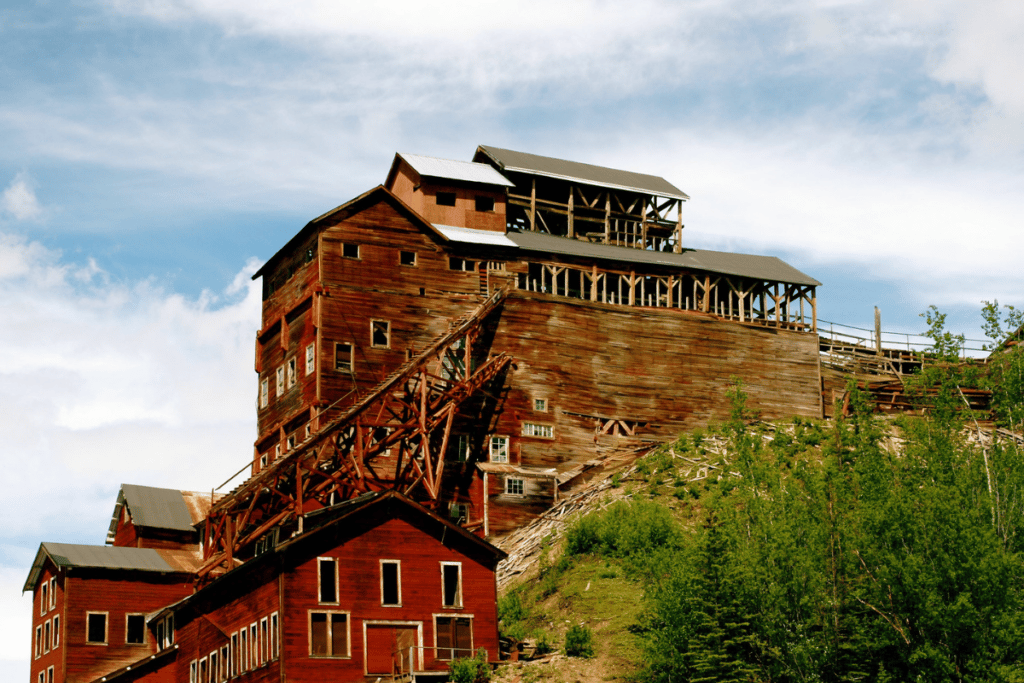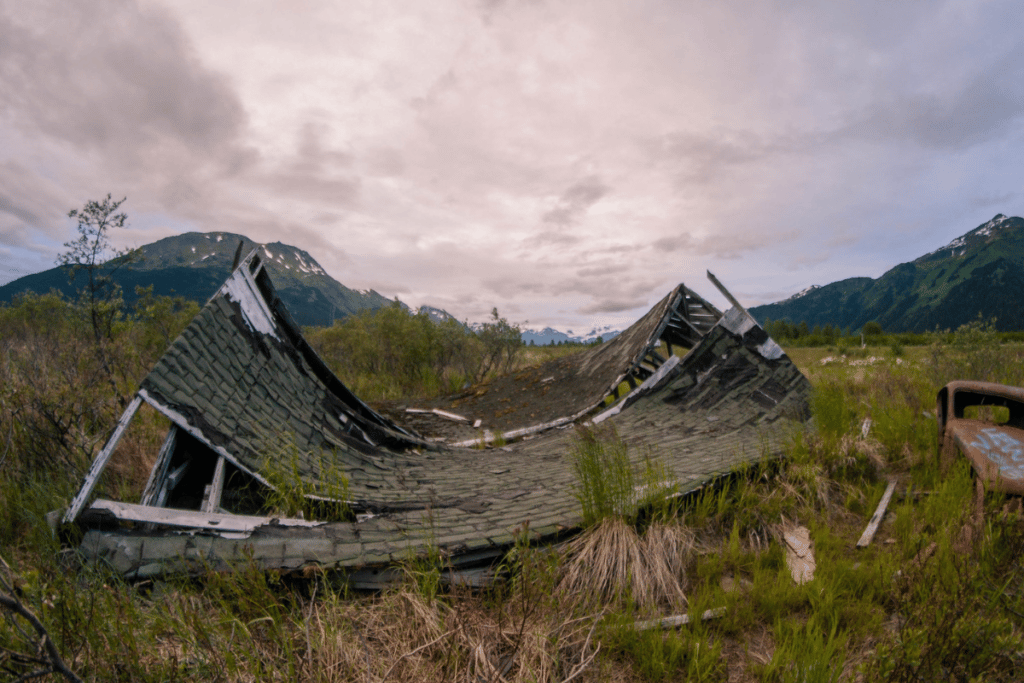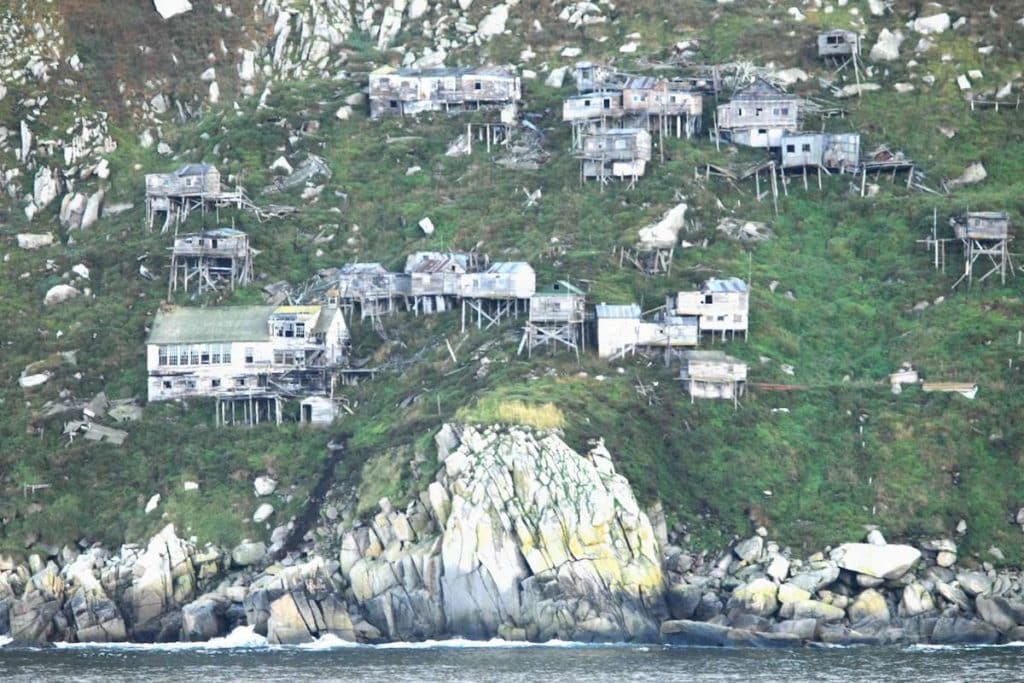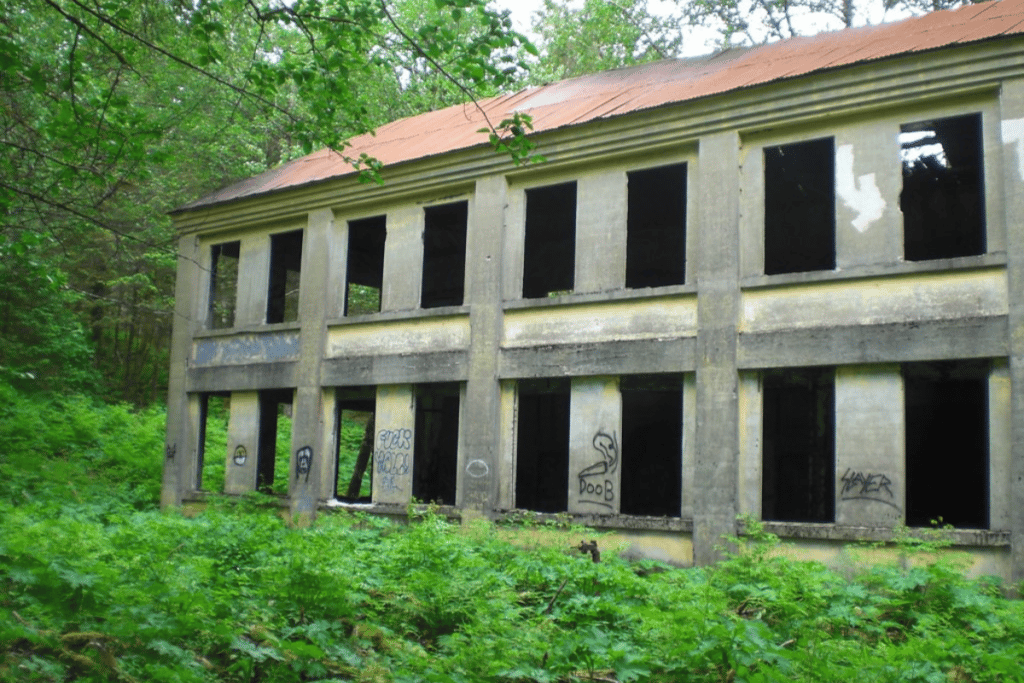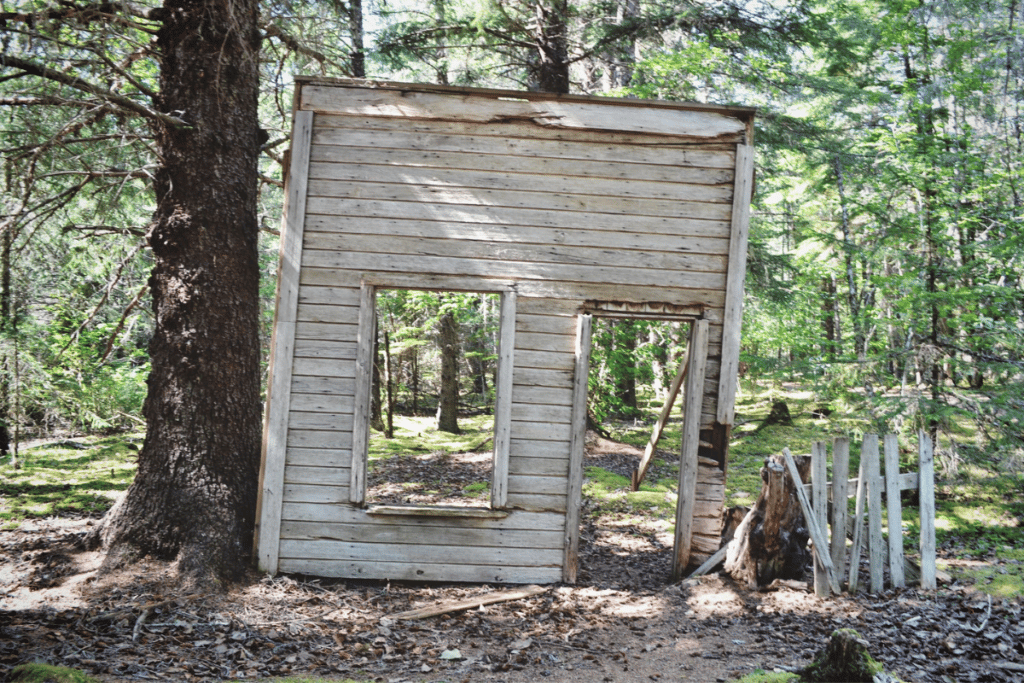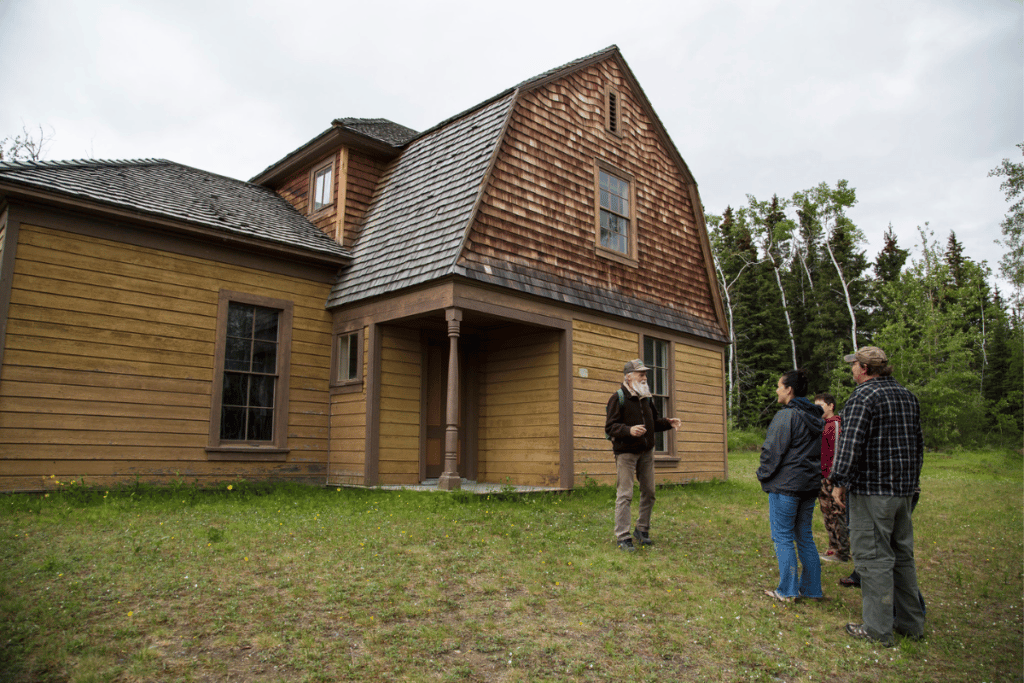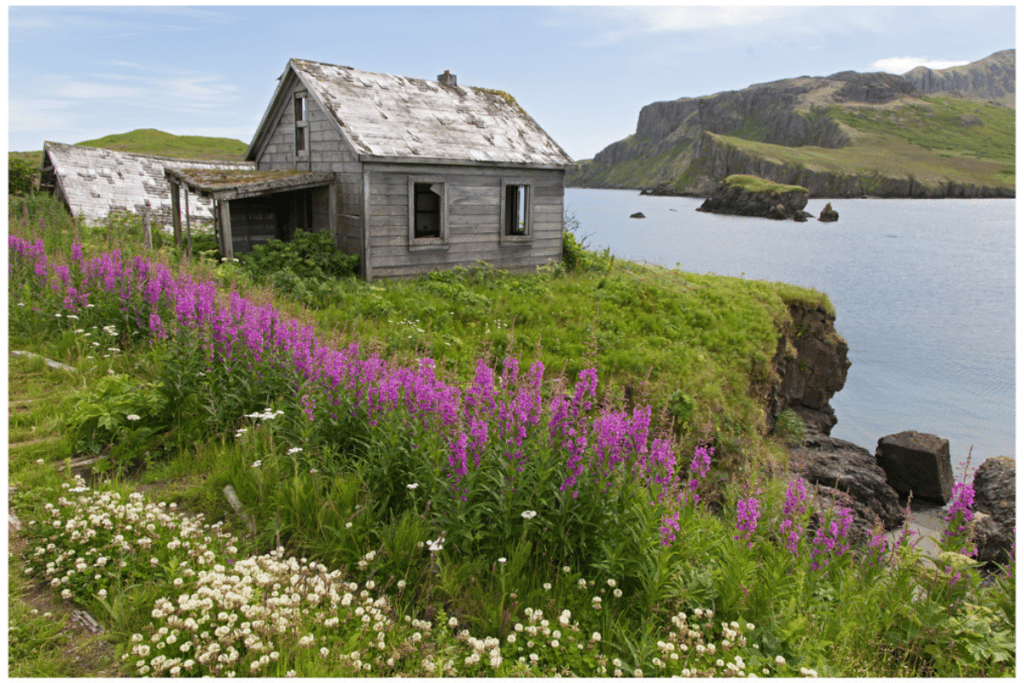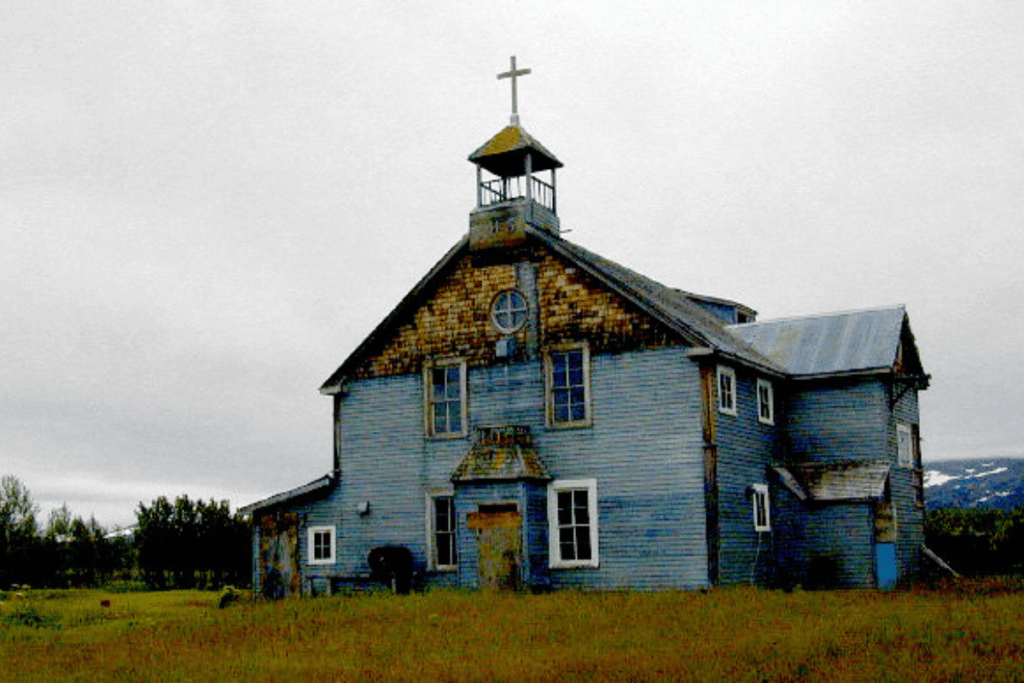Temperatures are dropping, the leaves are changing colors, and there’s something crisp in the air. Autumn is almost here, and we are getting in the mood for everything spooky.
Alaska is beautiful, but it does have its share of ghost stories!
While we have not seen any ghosts personally, a ghost town can refer to a city that has been abandoned or otherwise left to its own devices by its citizens.
As the Gold Rush swept through Alaska in the late 1800s, hopeful future gold tycoons rushed from location to location with the hopes of building their wealth. Unfortunately, this meant that many towns were abandoned as the residents moved quickly to the next gold strike discovered.
Tragic events such as hurricanes and earthquakes also contributed to the abandonment of these towns.
In fact, at this point, Alaska has at least 100 abandoned settlements1 in the state. That doesn’t include some of the more significant buildings that housed large populations that have also been left and have since fallen into disrepair.
Read on to learn more about some of the most infamous ghost towns in Alaska and their dark and mysterious pasts.
1.) Kennicott Ghost Town
The town of Kennicott, Alaska, was once the world’s richest copper mine.
The history of this great town started in the summer of 1900. Prospectors Clarence Warren and Jack Smith were out exploring Kennecott Glacier when they came across the richest concentration of copper ore ever discovered in the world.
Located deep in the Wrangell-St Elias National Park, construction started on the infamous railroad, the Copper River Northwestern Railroad, that ended up transporting miners and their families to Kennicott and copper back down to the ocean.
In its heyday, Kennicott was home to a school, a hospital, a saloon, and of course – a brothel. Over 200 people worked in the mines and 300 in the town itself. Over 200 million in copper was extracted over the thirty-year life span of the mines.
As the mines began to empty, the town was abandoned by its citizens in 1938. Many left their possessions behind, and by the 1950s, the town was completely deserted.
Nowadays, the town of Kennicott has only a dozen year-round inhabitants. It has become a popular summer tourist destination and is quiet and peaceful in the winter. There are not many homes to build back a large and robust town, but nearby McCarthy is growing swiftly.
The town and its remains have been acquired by the National Park Service, who are reconstructing some of the old mill buildings and undergoing significant preservation work.
This beautiful old ghost town is now a National Historic Landmark, and has become one of Alaska’s most popular tourist destinations. You can visit and take one of the many tours available through some of the old structures.
Contact Information
- Website: nps.gov
- Phone: (907) 554-1105
- Address: Kennicott, Chitina, AK 99566
2.) Portage Ghost Town
At 5:36 pm on March 27, 1964, the second largest earthquake in recorded history hit the small town of Portage, Alaska.
Though it only lasted four minutes and 38 seconds, the damage was irreparable. Tragically, 138 people lost their lives. The entire town sunk 6-10 feet, putting it below the high water mark. This caused devastating floods, making reclaiming their homes nearly impossible.
After the quake, the residents decided to relocate rather than rebuild and repair the extensive damage done to the area.
Today, some of the abandoned remains of the town still stand. It is easy to see the remnants of this ghost town as you drive by on the Seward Highway.
Located just outside of Girdwood, Alaska, these haunting remains are sinking into the earth outside of the Cook Inlet.
The abandoned town is surrounded by a “ghost forest,” as the trees end up petrifying in the salt water after their roots drop down 10 feet into the saltwater inlet.
3.) Sulzer, Prince of Wales Island
Sulzer was once a copper mining town. The town was named after William Sulzer, who created the Alaska Industrial Company.
Nestled in the woods of Tongas National Forest, the Jumbo mine ran and operated from 1907 to 1918. During its peak years, it was one of Alaska’s top copper-producing mines. It was one of many copper mines in Alaska that helped the economies of local towns during this time period.
After the copper mine played out, the town became a fishing village and cannery. But eventually, even those practices were abandoned in this area.
Today, there are very few remains of the town of Sulzer and no inhabitants or businesses. Interested explorers need a boat or plane to access the island!
4.) Ukivok
Ukivok is a hillside town in Alaska that has been abandoned for over 50 years.
The town of Ukivok was built by the Aseuluk or Ukivokmiut. They were seafarers and able to remain close to the water by constructing their town on a steep slope by the ocean on King Island.
This visually stunning town was home to about 200 residents. The impressive village was built onto the side of a 45º hill. The town built on stilts is a fantastic sight even to this day.
The town began its exodus when the Bureau of Indian Affairs forced the closure of the Ukivok school, sending all children to school on the mainland.
Eventually, the entire Ukivokmiut population relocated, leaving behind their small village. Even as the buildings fall into disrepair and rejoin the earth, the sight of these homes perched on a steep mountainside will leave an impression.
5.) Treadwell Ruins
This ghost town is located right outside our very own capital city, Juneau.
Treadwell was once a thriving mining town from 1833 to 1917. This impressive town was huge, and boasted five mills, many stores, mess halls, bunkhouses, and even a marching band! The most impressive feature of this small town? Alaska’s first indoor swimming pool, also known as a natatorium.
But then tragedy struck.
A high tide, and unsafe mining practices, led to a cave-in. Horses, mules, and extensive amounts of equipment were lost during this tragic event, resulting in three of the four mines completely flooding.
Luckily, no human lives were lost during the event, but most of the equipment, as well as mules and horses, disappeared beneath the water and earth.
There was only one mine that didn’t flood, the Ready Bullion Mine, and it continued its operations until 1922. But with the shutdown of the other mines, residents left until the town ended up as the ghost town you see today.
Today, it is empty except for the visitors and tourists who hike to come to see the abandoned Treadwell mine.
You can reach these ruins on the Treadwell Mine Ruins Trail, a relatively easy hike. This two-mile loop outside of Douglas, Alaska can be finished in under an hour.
There is plenty of parking available at the start of the trail and lots to see and do in the area.
6.) Dyea
Dyea, Alaska, is a small ghost town outside Skagway with a long and exciting history based on the Klondike Gold Rush of 1897-1898.
Even before the Gold Rush, Dyea was possibly a permanent village, and at the very least, a seasonal fishing camp as well as a staging area for trade trips made between the interior and the Alaska coast.
The small town was the staging spot for many of the gold miners heading up the Chilkoot Trail, a
On April 3, 1898, there was a massive snow slide, known as the “Palm Sunday Avalanche,” on the Chilkoot Trail. This considerable disaster happened north of Sheep Camp and killed over 70 travelers. This brought worldwide negative publicity, to the small village, and many travelers steered away from Dyea.
With the opening of the White Pass & Yukon Route railroad to travelers, few made the trek on foot over the pass, instead choosing to travel in relative comfort quickly over the mountains.
Today the town is all but deserted and resides within the Klondike Gold Rush National Historical Park, a division of the National Park Service. Hikers hoping to complete the Chilkoot Trail find their way through this ghost town.
Other visitors from Skagway can explore the abandoned buildings and learn a little more about this ghost town’s history.
7.) Three Saints Bay
Three Saint’s Bay was the first Russian colony in America and a settlement on Kodiak Island. Located on a nine-mile inlet and founded in August 1784 by Grigorii Shelikhov, Three Saints Bay was named a National Historic Landmark in 1978.
In 1792, both an earthquake and a tidal wave destroyed the settlement. The town’s residents then moved to Kodiak instead.
This historical site also represents the Three Saints phase of the Kachemak tradition, a late prehistoric culture on Kodiak Island. There are no remains in this ghost town, so unfortunately there is nothing to explore, and it is not open to public visits.
8.) Fort Egbert
Fort Egbert, located in Eagle, Alaska, was established in 1899 by a population of just under 1,800 miners and residents that were hoping to find gold. As we have seen demonstrated with other abandoned towns, it was abandoned when other cities had more auspicious opportunities for striking it big.
Though Fort Egbert was only a thriving town for about 12 years, five of its buildings remain today and are protected by the Eagle Historical Society. But its short existence was essential to Alaska’s history and helped shape its ties with the rest of the United States.
You can visit this abandoned town by driving the 160-mile Taylor Highway to the Yukon River. This restored military outpost is operated by the Bureau of Land Management, with help from the National Park Service and the Eagle Historical Society and Museums.
If you want to visit this charming ghost town on what feels like the edge of the world, try the 18-site Eagle Campground, which is just a short walk from the fort and abandoned town.
Contact Information
- Address: Eastern Interior Field Office MP 160.3 Taylor Highway, AK
- Phone: (907) 474-2200
- Email: [email protected]
- Website: blm.gov
9.) Unga
In the Aleutian Islands, about two miles west of Sand Point, you will find Unga Island. And in Delaroaf Harbor, you will find the abandoned town of Unga.
Though it was established in 1833, by 1969, the last family had moved away after the residents steadily dwindled.
Visitors can explore what remains of the settlement, including homes and structures. On your visit, you may have the chance to see a wide variety of wildlife like puffins and sea otters. Besides guests visiting for the history and natural beauty, Unga is now largely only used for subsistence activities.
Hurtigruten Expeditions offers sightseeing tours on the island, where you can partake of a nature landing on their expedition boats and explore the abandoned town.
Contact Information
- Hurtigruten Expeditions
- Phone: +441224980439
- Email: [email protected]
- Website: global.hurtigruten.com
- Social Media: Facebook | Instagram | Twitter | YouTube
10.) Pilgrim Hot Springs on the Seward Peninsula
You have learned about towns that have been abandoned, but have you heard of one that is sinking away?
Also known as Kruzgamepa, Pilgrim Hot Springs is located on the southeast bank of the Kruzgamepa River and in one of the most beautiful areas of the Seward Peninsula.
In 1918, Catholic priest Father Bellarmine constructed a church, orphanage, greenhouses, and lodging for staff as part of his mission about 60 miles northeast of Nome, Alaska. These buildings were kept warm by water piped in from the hot springs.
The grounds are abandoned and sink into the surrounding hot springs, that is home to water temperatures that reach up to 178 degrees.
Since then, the site has been registered with the National Register of Historic Places and is owned and operated by seven Alaska Native area organizations in the Bering Strait region.
You can visit this stunning place and experience the history and the hot springs firsthand.
11.) Buckner Building in Whittier, Alaska
Most Alaskan ghost towns have roots in the gold rush and late 19th century, but the Buckner Building is one of the younger abandoned buildings.
Originally built and completed in 1953 as a large military base, the Buckner Building was a self-contained city. Within its walls were a hospital, barbershop, theatre, library, housing, and even a jail. Known as the “City Under One Roof,” you never had to leave if you didn’t want to, which made for a cozy place during the long Alaskan winters.
After World War II, in 1960, the building was abandoned when the Army Port of Whittier was shut down. The government claimed they had run out of uses for it. The building suffered even further damage after the earthquake of 1964.
Visitors are prevented from entering the building due to unsafe conditions, including asbestos and standing water, but the creepy skeleton of this bizarre building remains to view from a distance.
12.) Jesse Lee Home
While not technically a ghost town, we wanted to include this building in Alaska that has been reported as having unusual paranormal activity after the large building was abandoned.
In the early 1900s, the Jesse Lee Home was established in Seward after relocating from the Aleutian Islands. Seward was an up-and-coming transportation hub, making it a desirable location.
The boarding school was home to many children and orphans, including Benny Benson, the designer of the Alaskan flag.
Tragically, the orphanage experienced so much damage during the Seward earthquake of 1964 that they had to relocate to Anchorage, leaving what was left of their second building.
Forty years after being abandoned, reports of paranormal activity started happening from people on the property after nightfall.
In 2020, the building was mostly demolished, and the area was rezoned as a park. While most of the building has been removed, you will still find parts of the foundation, stairs, and a concrete boiler room left.
There’s never a shortage of mystery and adventure in Alaska! With such a large amount of land, it’s easy to have many hidden ghost towns all over the state. And after the boom of the Gold Rush, it’s no surprise that many of these towns have been abandoned, becoming the ghost towns of Alaska.
If you are looking for more Alaska-based activities to get your adrenaline pumping, explore these 11 rafting adventures. You can also find free things to do in Anchorage while you spend a few days there.
Sources:
1.) https://www.gi.alaska.edu/alaska-science-forum/ghost-towns-scattered-across-alaska-map
After living over 14 years in Alaska, Megan McDonald can confidently state that there’s not much of the state on the road system that she hasn’t visited. From the Brooks Range to McCarthy, Homer, and everywhere in between, every nook and cranny of Alaska is always her new favorite place.
As President and co-founder of Alaska-based boutique media agency HuMu Media, she spends her work time writing, photographing, and traveling, and her off time writing, photographing, and traveling. They say do what you love, and she is lucky enough to do so!
You can follow her travels on Instagram at @theitinerantginger

